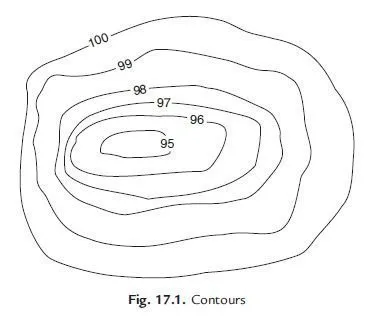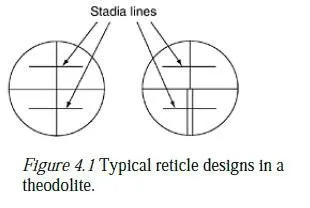A contour line is a imaginary line which connects points of equal elevation. Such lines are drawn on the plan of an area after establishing reduced levels of several points in the area. The contour lines in an area are drawn keeping difference in elevation of between two consecutive lines constant. For example, Fig. 17.1 shows contours in an area with contour interval of 1 m. On contour lines the level of lines is also written.
Characteristics of Contours
The contours have the following characteristics:
1. Contour lines must close, not necessarily in the limits of the plan.
2. Widely spaced contour indicates flat surface.
3. Closely spaced contour indicates steep ground.
4. Equally spaced contour indicates uniform slope.
5. Irregular contours indicate uneven surface.
6. Approximately concentric closed contours with decreasing values towards centre (Fig. 17.1)
indicate a pond.
7. Approximately concentric closed contours with increasing values towards centre indicate hills.
8. Contour lines with U-shape with convexity towards lower ground indicate ridge (Fig. 17.2).
9. Contour lines with V-shaped with convexity towards higher ground indicate valley (Fig. 17.3).
10. Contour lines generally do not meet or intersect each other.
11. If contour lines are meeting in some portion, it shows existence of a vertical cliff (Fig. 17.4).
12. If contour lines cross each other, it shows existence of overhanging cliffs or a cave (Fig. 17.5).

Uses of Contour Maps
Contour maps are extremely useful for various engineering works:
1. A civil engineer studies the contours and finds out the nature of the ground to identify.
Suitable site for the project works to be taken up.
2. By drawing the section in the plan, it is possible to find out profile of the ground along that line. It helps in finding out depth of cutting and filling, if formation level of road/railway is decided.
3. Intervisibility of any two points can be found by drawing profile of the ground along that line.
4. The routes of the railway, road, canal or sewer lines can be decided so as to minimize and balance earthworks.
5. Catchment area and hence quantity of water flow at any point of nalla or river can be found. This study is very important in locating bunds, dams and also to find out flood levels.
6. From the contours, it is possible to determine the capacity of a reservoir.







This information is understable
Good easily can understand